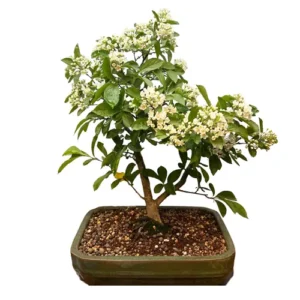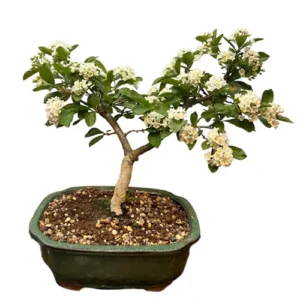Forsythia
Forsythia Bonsai
Native to East Asia. Forsythia are hardy deciduous that flower early in Spring with a sparkling range of yellow flowers. While common garden plants, these species make for spectacular Bonsai in cascade, root over rock and informal styles.
Forsythia Bonsai Care Tips
Placement
An outdoor environment that provides full sun across the year. Only light shade is required in the hottest peak of the year. For the winter months, these are hardy specimens to -10 degrees C.
Watering
During the growing season, Forsythia requires watering regularly. The soil mix should not be allowed to entirely dry out. this is particularly vital during autumn as next year’s buds will be forming. During winter the compost needs to be kept moist.
Feeding & Fertilising
Forsythia bonsai should be fed fortnightly during the growing season. After flowering a general fertiliser can be used. Towards the end of summer, a feed low in nitrogen will aid the plant’s vitality.
Pruning & Wiring
Pruning your bonsai is important not only to create or maintain an aesthetic style but to also ensure optimal health. Branches should be pruned back hard after flowering. Growth can be pruned out until the middle of summer. Minimal pruning can be carried out after next spring’s flower buds are forming.
Wiring should only be done for branches growing in the wrong direction. The wire should be kept on for no longer than a year. We recommend using wires with a thickness that matches the thickness of the branch: if the wire you choose is too thick you will damage the bark. If it is too thin, it won’t be effective.
Repotting
Repotting your tree is an important way to provide a fresh and suitable soil mix and ensure appropriate root health. Forsythia bonsai should be repotted every two or three years, following flowering, in Spring.
Trees that are ready for repotting will require root pruning, a suitable new pot and appropriate soil mix.
When repotting, do not cut back the root mass by a large amount, and choose a well-draining soil mix that has a neutral or slightly higher PH value of 5-6 but not over 7. We tend to use a mixture of different speciality bonsai soils on our trees. Every species is different so please contact us for free soil-mix advice or to take advantage of our repotting service.
Bonsai trees aren’t only magnificent additions to an indoor oasis, they are more than capable of standing out in any garden. Many Bonsai species are incredibly hardy and withstand nature’s colder and damper turns with aplomb making them worthwhile outdoor plants. We have an extensive library of care guides for outdoor bonsai trees. It’s not about selecting the perfect bonsai, it’s about selecting the perfect bonsai for you.
Forsythia Bonsai - Typical Queries
How to propagate a Forsythia bonsai?
Forsythia bonsai can be propagated through cuttings and division. If using division, do so at the start of Spring and in Winter. Semi-ripe cuttings should be rooted in the summer. Greenwood can be rooted in the late Spring.
Do Forsythia bonsai get pests and diseases?
This bonsai isn’t prone to disease. This being said it may incur gall which could affect the plant as a whole. Aphids may arise but usually in limited numbers that are dealt with by hand. Its flower buds may also be fodder for birds at the opening of Spring.
Be aware this isn’t a long-living species, their trunks tend to rot with age. If rot has set in to such an extent it’s riddling the tree, it’s best to start over with another younger plant.
Can you keep a Dawn Redwood bonsai indoors?
This is a hardy deciduous species that thrives outdoors with full sun. Keeping indoors is unadvisable.





















